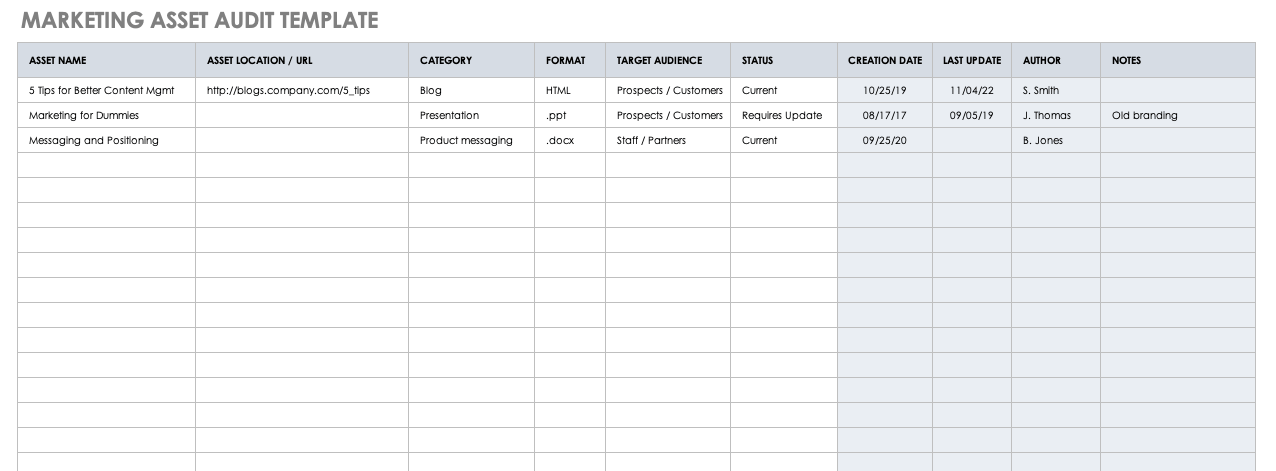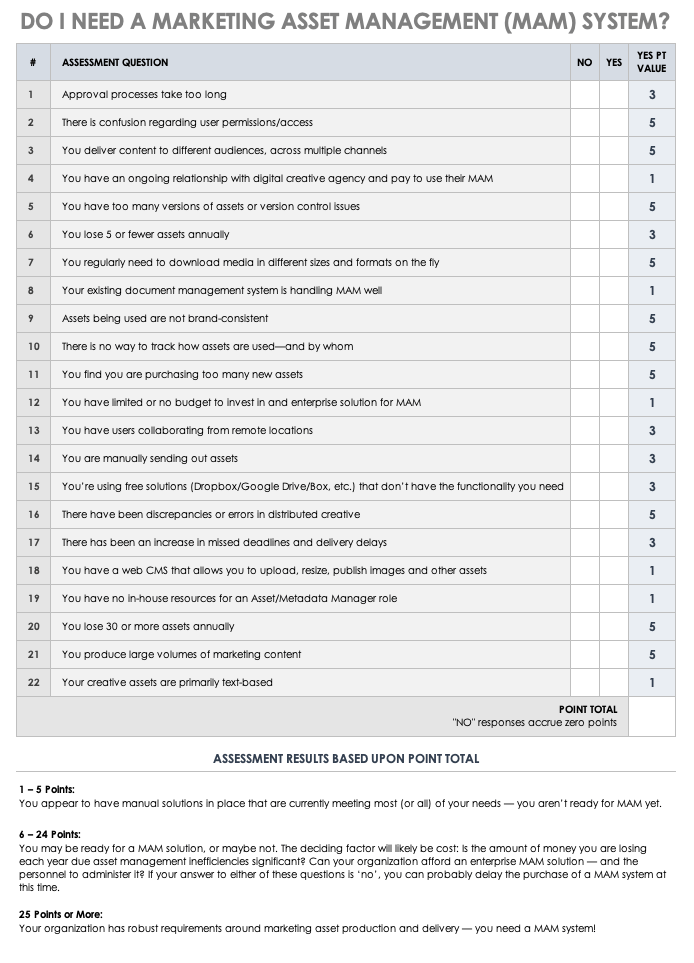What Are Marketing Assets?
Marketing assets include anything used by an organization to promote its products, services, or brand. Emails, brochures, datasheets, presentations, sales letters, blog articles, website content, videos, and images are some of the most popular assets available to external customers.
The company’s marketing strategy determines the type of assets that are most valuable to its audience. Inbound marketing focuses on the most modern buyer — one who researches the product before contacting the company. Inbound marketing activities are designed to attract prospects that are in the market for the product or service you offer.
For example, a blog article that includes tips and best practices on organizing closets will attract people who are likely in the process of decluttering and organizing their homes. If your specialty is building custom closets, this thought leadership blog will help you attract prospects and communicate to the buyer that you are an expert in this industry. On the other hand, outbound marketing markets to people regardless of whether they are looking for a product or service that you offer. Television commercials, online ads, and billboards are some outbound marketing tactics.
Some marketing assets are used only for the internal purpose of motivating and empowering employees to promote the company and product to customers. For example, an internal brand guide might advise employees on the consistent use of logos, colors, fonts, image style, and language, while a product messaging presentation might train the sales team on product messaging. Below is a list of internal and external marketing assets:
Internal:
- Training materials
- Brand guide
- Cheat sheets
- Emails
- Messaging matrix
- Competitive sell sheets
External:
- Emails
- Brochures/datasheets
- Whitepapers/ebooks
- Case studies
- Blog articles
- Logos
- Videos
- Images
- Audio podcasts
- Website content
- Infographics
- Social media
- Advertisements
- Annual report
- Business cards
- Trade show/event/billboard displays
- Commercials
Commonly stored in a repository for easy access and usage, marketing assets move through a lifecycle, from creation to the point at which they are outdated and no longer useful. Below is an example of the marketing asset management lifecycle.
What Is Marketing Asset Management?
Marketing asset management is the administration of marketing assets in a central location for easy distribution and usage.
Marketing asset management is related to enterprise content management, digital asset management, brand management, and media asset management, but is not to be confused with asset management marketing, which is the marketing of investment assets. Although the terms are similar, they mean vastly different things.
Why Is Marketing Asset Management Important?
The marketing department is responsible for contributing to a business’s bottom line. One of the department’s responsibilities is to produce critical business assets that support global campaigns and empower staff to promote and sell products or services. However, tracking and monitoring all these materials can quickly become overwhelming. Eventually, after your company has developed numerous assets, it becomes impossible to remember every asset you’ve created. It also becomes too time consuming to find assets and too complicated to collaborate without a central repository.
Imagine a company that distributes a brochure to its entire sales team via email. The team uses the brochure to attract prospects and sell the product. But, what happens when that brochure needs to be updated? Who has the original design? Who is using the brochure and requires the updated version? Decentralized and fragmented marketing asset management degrades the ability to maintain brand consistency and accurate information. Moreover, team members end up wasting time searching for information and performing redundant work to recreate assets.
Globally distributed marketing organizations that interact with print providers, agencies, cross-functional team members, partners, vendors, franchisees, IT staff, HR staff, branch managers, and contractors require a more robust management of marketing assets.
“Managing marketing assets typically doesn’t seem important until people start to have trouble finding previously created resources,” says Jennifer Holtvluwer, Senior Director of Marketing and Inside Sales at Alcatel-Lucent Enterprises. “Employees spend countless hours searching for content and are sometimes forced to reinvent the wheel. This frustration is usually the catalyst for a structured marketing asset management solution. I strongly urge all organizations to develop a strategy to manage marketing assets before those assets become unruly. With a well-developed strategy, most companies will net an almost immediate ROI.”
The Benefits of Marketing Asset Management
Fast-changing market demands and competitive conditions put pressure on marketing teams to respond more quickly and with more agility. Marketing asset management helps streamline the tracking and monitoring of essential business materials. The ability to digitally control marketing assets ensures that all assets are accessible, easy to find and share, brand compliant, and available for global campaigns.
The most significant benefit of marketing asset management is quick, uncomplicated accessibility. What good is an asset if no one can find it? If you have ever dealt with the annoyance of trying to find a critical campaign or program asset, you know the frustration and loss of productivity all too well.
Time is money, and marketing asset management provides a fast return on investment. Proper management of your marketing assets means no more digging through file folders, emailing the entire team, or logging into an old server to perform a search.
With the ability to locate a branded, current asset, you’ll reap the following benefits:
- Increase business performance and revenue growth.
- Improve communication, productivity, creativity, and collaboration.
- Create autonomy for local marketers, partners, sales, resellers, and third parties.
- Reduce time searching for assets.
- Reduce redundant recreation work.
- Maintain brand consistency.
- Repurpose assets for improved ROI.
How to Organize Marketing Assets So They Are Easy to Find
The number one goal of organizing marketing assets is to get them all in one centralized repository or marketing asset library. Ideally, you’ll have an online system that supports a variety of file types and is easy for users to access from any location. Below are tips for organizing marketing assets, so they are simple for any user to locate:
- Standardize file names and include a date and version.
- Implement a marketing asset repository or marketing asset management system.
- Categorize assets.
- Apply a status to each asset, such as current, needs update, or archive.
- Archive outdated assets.
Simply starting with standard file naming conventions can help you get more organized. For example, you could name your files according to asset type, asset name, and creation date, respectively so that the result would look something like this: blog_5tipsforbettermarketing_12172019.docx.
Tips and Best Practices for Marketing Asset Managers
An abundance of marketing assets can quickly make the most seasoned digital marketing asset manager or content manager’s head spin. Below are some tips to help you take control of marketing assets:
- Audit All Marketing Assets: An examination will help paint a clear picture of the assets you have on hand. Assign each asset a status of current, outdated, or requires update.
- Gather Marketing Asset Management System Requirements: Identify the features and functionality that are essential for managing marketing assets. Look at your current system and establish a list of what works for your business, what is unnecessary, and what is missing. For example, do you need asset usage reports and sharing through email?
- Decide on the Solution Delivery Model: Cloud, hybrid, or on-premises options are available based on budget needs and your organization’s infrastructure.
- Provide Training and Guidance: Establish usage guidelines that span the creation of content, version control, and proper use of assets. These guidelines include how to identify relevant assets and share them securely. Consider tagging assets as approved to ensure they are fully compliant with business requirements.
- Monitor Usage: Use integrated reporting and monitoring tools to understand asset usage and interactions.
This marketing asset audit template will help you audit your existing marketing assets. List all your assets, assign each one a status, link to its current location, and include notes. Use this spreadsheet not only to gain visibility into what you have, but also to identify gaps and spot opportunities for new, valuable assets.
Download Marketing Asset Audit Template
Marketing Asset Management Technology and Tools
The audit information is beneficial for both streamlining the organization of assets and finding a suitable system. For example, have you ever worked in a company that organizes its files, but has an unclear file directory structure? Where would you look if you needed an advertisement that was part of a marketing campaign? It could be in the images folder, marketing assets folder, or campaign assets folder.
A marketing asset management tool will help you in all the areas of managing marketing assets that can be challenging — organization, naming conventions, searching, sharing, and much more. Let’s look at some of the most popular marketing asset management solutions on the market:
| Company | Category | Founded | Target Audience | Customers |
|---|---|---|---|---|
| Bynder | Digital asset management | 2013 | Brand managers, marketers, and creatives | Puma, Icelandair, Five Guys |
| Canto | Digital asset management | 1990 | Marketing teams | NASA, Harvard University, United Airlines |
| HubSpot | Content management | 2005 | Professional marketers | Atlassian, DoorDash, VMware |
| MarcomCentral | Marketing asset management | 2000 | Modern marketers | Subway, Chevron, Volvo |
| Widen | Digital asset management | 1948 | Marketing, sales, and technical teams | Yeti, Brooks, Indiana University |
| Smartsheet | Work management and automation | 2006 | Managers, teams, information workers | Office Depot, PayPal, Cisco |
Marketing Asset Management Solution Features and Infrastructure
Deciding which solution is the best fit for your organization depends on your business model, infrastructure, and business requirements. A large enterprise may find a digital asset management solution that extends beyond marketing to provide the most ROI, whereas a small firm may only need basic functionality that supports the management of marketing assets and is easy to implement. As you evaluate solutions, consider the following features:
- File Management: Use a central collection hub that stores a variety of file types, enabling easy search, share, distribution, and collaboration.
- Workflow Automation: Streamline the creation, proofing, and approval of assets.
- Configuration: Possess the flexibility to use predefined templates and personalize system configurations in order to meet your unique business requirements.
- Security: Ensure secure authentication with the ability to designate user roles with predefined permissions.
- Brand Management: Brand management is a byproduct of marketing asset management. The ability to manage assets in a single repository provides control over brand consistency.
- Publishing: Publishing gives you the ability to deliver assets across platforms, including social media, websites, and email.
- Integrations: Integrate with creative tools, social media solutions, email systems, and other software solutions.
- Metadata: Title, category, creation date, keywords, and author are a few examples of metadata that make searching for assets much more efficient.
- Reporting and Analytics: Usage measurements, printing trends, and other shared data provide insight that is useful for continual improvement.
- Mobility: This feature allows on-the-road workers to access, create, edit/customize, and share assets via a mobile device.
Do You Need a Marketing Asset Management System?
We have looked at the benefits of marketing asset management, so we know why it is essential. We have also included a list of some of the most popular marketing asset management products, but you may still be on the fence about whether this kind of management is right for you. Use this “Do I Need a Marketing Asset Management System?” template to help determine if you need marketing asset management.
Download Do I Need a Marketing Asset Management System? Template
Manage Your Marketing Programs with Smartsheet
The best marketing teams know the importance of effective campaign management, consistent creative operations, and powerful event logistics -- and Smartsheet helps you deliver on all three so you can be more effective and achieve more.
The Smartsheet platform makes it easy to plan, capture, manage, and report on work from anywhere, helping your team be more effective and get more done. Report on key metrics and get real-time visibility into work as it happens with roll-up reports, dashboards, and automated workflows built to keep your team connected and informed.
When teams have clarity into the work getting done, there’s no telling how much more they can accomplish in the same amount of time. Try Smartsheet for free, today.


